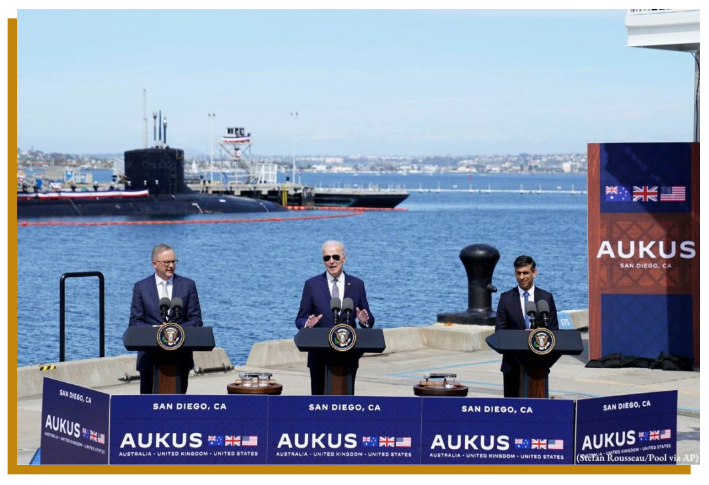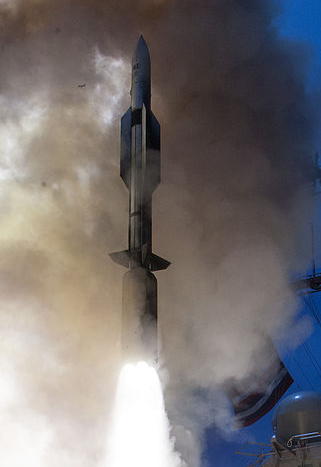In the past few weeks, the Philippines media has been flooded by an orchestrated messaging machinery aiming to portray the trilateral rearmament as peace-building. In its view, a massive threat (China) led to the trilateral alliance.
In reality, the trilateral alliance seems to be the result of a U.S. maritime counter-insurgency (COIN) campaign since 2016, resting on the work of the U.S. Navy Department; Project Myoushu, a derivative of the COIN; a Stanford think-tank and its SeaLight initiative, sponsored by the U.S. Office of Naval Research; and the Center for Strategic and International Studies and its Asia Maritime Transparency Initiative (AMTI).
The purpose of the maritime counter-insurgency campaign has been to escalate the South China Sea friction, to justify trilateral militarization.
But that's only a prelude to the ongoing massive rearmament drive that has potential to undermine the Asian Century.
Nuclearization via QUAD and AUKUS
In March 2023, U.S. President Joe Biden held a press conference on the AUKUS partnership with UK Prime Minister Rishi Sunak and Australian Prime Minister Anthony Albanese at Naval Base Point Loma in San Diego, California. During the conference, the nuclear-powered USS Missouri submarine was visibly in the background, by design. It was a signal to China (Figure 1).
Figure 1 The Trilateral AUKUS Partnership

Source: Screen capture from U.S. Embassy & Consulates in China, Mar 13, 2023
Ironically, the net effect is rising nuclearization of the South China Sea by countries that are not located in the ASEAN territories. The U.S.-led multilateral security framework that's targeting China rests on the QUAD (Quadrilateral Security Dialogue) between the U.S., Japan, Australia and India.
But AUKUS is more actionable. It seeks to hem in China’s moves with a nested military network, including sharing advanced military technologies such as nuclear-powered submarines. The first subs will be built in the UK by the late 2030s and in Australia after 2040.
In the interest of time, the U.S. plans to forward-deploy Virginia-class nuclear-powered submarines, coupled with the UK’s similar Astute-class subs, to a naval base near Perth in Western Australia, already by 2027. AUKUS is also likely to expand in 2024 or early 2025. Japan and Canada are in line to join the so-called pillar 2 section of the AUKUS agreement, while the U.S. is courting South Korea and New Zealand.
From the Chinese viewpoint, the U.S. is expanding the AUKUS military alliance by “forming a mini-NATO in Asia, which poses unprecedented threats and challenges to the region's prosperity and stability.”
But nuclearization takes time. The Pentagon and the Big Defense want to move faster. Hence, the missiles.
Missiles and militarization
As veteran political analyst Francisco Tatad writes, "Marcos sees China as the source of the danger, but he does not say why our two countries should be going to war with each other over some pieces of stone in the vast disputed sea." Tatad asks, “Whose war must we prepare for?”
The question about “whose war” remains blurry, unlike the question “how” it could begin. Due to the 2019 expiration of the previously banned Intermediate-Range Nuclear Forces Treaty, the U.S. is planning to deploy ground-based intermediate-range missiles in the Indo-Pacific already in 2024, thus establishing its first arsenal in the region since the end of the Cold War.
Originally developed by the huge U.S. defense contractor Raytheon which has played a vital role in Ukraine, these missiles feature land-based versions of the Standard Missile-6 (SM-6) and the Tomahawk cruise missile, with ranges between 500 and 2,700 kilometers (Figure 2). Tomahawks in particular have been used from the Gulf War to Iraq, Syria and Yemen.
Figure 2 Missiles over South China Sea?

The Arleigh-Burke class guided-missile destroyer USS John Paul Jones (DDG 53) launches a Standard Missile-6 (SM-6) during a live-fire test of the ship's aegis weapons system (Pacific Ocean, June 19, 2014)
Source: Wikimedia Commons
Reportedly, the U.S. Army will send the intermediate-range missile units primarily to the U.S. territory of Guam, looking for more forward deployment to Asian allies in a contingency. But allies, like the Philippines, are likely expected to be open to “rotational deployments in crises.”
Responding to a crisis in the Taiwan Strait or South China Sea will require missiles that can reach targets in those critical waterways or the Chinese mainland. This means an extended deployment near the “first island chain,” which stretches from Japan's Okinawa islands to Taiwan and, yes, the Philippines.
How did Manila end at the edge of the abyss?
Pre-Marcos steps to militarization
The U.S. Naval Department’s involvement seems to have intensified since the mid-2010s, when the late foreign secretary Albert F. del Rosario had a key role in building the 2014 Enhanced Defense Cooperation Agreement (EDCA), which opened the country to U.S. military, ships, and planes; for the first time since 1991. A year later, Rosario met Obama’s then-deputy secretary of state Antony Blinken in Manila, aiming at bigger bilateral commitments (Figure 3).
Figure 3 Toward deeper military alignments

(Left) Foreign Affairs Secretary Albert F. del Rosario and US Deputy Secretary of State Antony Blinken in Manila on Nov. 18, 2015. (Center) Foreign Affairs Secretary Teodoro L. Locsin, Jr. receives U.S. INDOPACOM Commander Admiral John C. Aquilino, on Aug 21, 2021. (Right) Gen. Romeo Brawner, Jr., Armed Forces of the Philippines Chief of Staff (right), and Adm. John C. Aquilino, Commander of U.S. Indo-Pacific Command, in Manila on March 12, 2024. (Source: DFA, DFA-OPCD)
President Duterte’s electoral triumph in 2016 caused a six-year breather in these ambitious plans. Militarization accelerated in August 2021, when Admiral John C. Aquilino, Commander of the U.S. Indo-Pacific Command (INDOPACOM), met foreign secretary Locsin, Jr. During that visit, Adm. Aquilino welcomed bilateral progress as “a huge leap forward" and a U.S. press release described the ties as an “alliance."
Aquilino's calls matter. The INDOPACOM is the largest of six geographic combatant commands of the U.S. Armed Forces. It is responsible for all U.S. military activities in the Indo-Pacific region.
But nothing was set in stone, yet. President Marcos Jr had pledged building on the Duterte legacy and nurturing strong ties with both the U.S. and China, like most ASEAN nations. But obviously, these pledges had to go. They were misaligned with the Big Defense's plans for Manila. Peace is not good for military business.
In October 2022, Senator Imee Marcos, chair of Philippine foreign relations committee, still pleaded in Washington: “Do not make us choose between the United States and China.” While affirming the strong bilateral alliance, she said the latter should not inhibit expanded engagement with China through confidence-building measures, joint development, and finalizing a code of conduct in the South China Sea.
Prior to the address, her younger brother, President Marcos had met President Biden and discussed “the full breadth of issues in the alliance." Subsequently, all his major electoral pledges turned upside down. Trilateral mobilization became an inflated response to a deflated problem. As columnist Rigoberto Tiglao wondered why the Philippines should go to war with China, its biggest trading partner, over a dispute that “is solely over Ayungin Shoal, a permanently submerged, useless small area.”
Even Congress has been oddly numb about the tectonic foreign policy shift, despite its likely adverse and huge economic and geopolitical implications.
More bases, more targets
By February 2023, President Marcos Jr. granted U.S. forces access to four new bases, in addition to five existing bases included under the expanded Enhanced Defense Cooperation Agreement (EDCA). The controversial decision was opposed vehemently by several provinces and municipalities in the target areas. But once again, these concerns were quickly suppressed as anti-patriotic.
In a fall 2023 Senate hearing, Senator Robinhood Padilla did question the presence of a U.S. Navy Poseidon aircraft circling overhead during the resupply mission, as the U.S. naval presence unnecessarily caused an escalation between China and the Philippines. Instead of welcoming Padilla's valid skepticism as an opening for a democratic debate on the foreign policy U-turn, questions were hush-hushed away.
At the time, Adm. Aquilino returned to the Philippines to discuss "opportunities for increased multilateral cooperation, maritime security initiatives, and the upcoming exercise Balikatan." The U.S. has added 63 projects for the EDCA sites on top of the previously-approved 32. These projects included multipurpose storage facilities, road networks and fuel storage, "among others." Although the U.S. officially has only "rotational access" to the Philippines bases, it has already allocated over $109 million towards infrastructure improvements at some seven EDCA locations. Aquilino did not specify the purpose of the expanded military infrastructure.
Presumably, the Philippines is to serve as a logistical platform, in order to tie China in the South China Sea (SCS) before a potential Taiwan crisis. But more is needed. Aquilino sought access to still more bases.
Unsurprisingly, both sides preferred backroom talks to open public debate. Or as Adm. Aquilino said diplomatically, "We’ll have those conversations - I think in private, and give our bosses some decision space on how they’d like to go forward."
Eclipse of Southeast Asian economic engines
Until recently, Japan and the Philippines have been reluctant to host new American capabilities, to avoid becoming an immediate target of the Chinese military in a crisis. As economic challenges are amounting in both countries, things are changing.
The proponents of the trilateral militarization portray it as a pillar of “peace and stability” in Southeast Asia. They live in a parallel universe. In most ASEAN nations, militarization is seen to precipitate friction and instability in the region.
The consequent massive rearmament has potential to split Southeast Asia and bury the Asian Century. In this effort of friction, division and decline, the Philippines is now the key actor and one that carries the greatest risks.
